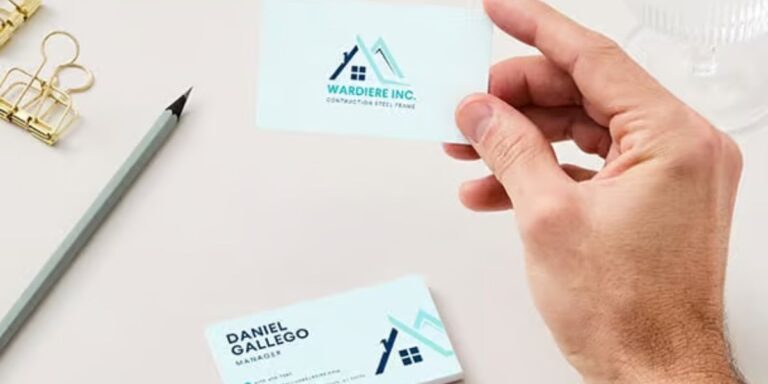Business cards are a powerful and traditional tool in the world of business. Despite the rise of digital communication, they remain a staple for professionals looking to network, promote their services, or leave a lasting impression. A small piece of card stock can speak volumes about you, your business, and the image you want to project.
Importance of Business Cards in the Digital Age
In an era where smartphones, social media, and email dominate the business landscape, one might wonder if business cards are still relevant. The truth is, they are. Business cards provide a tangible connection in an increasingly digital world. They offer a personal touch that cannot be replicated by sending a virtual contact or an email.
When you hand over a business card, it signifies professionalism and preparedness. It shows that you value the person you are interacting with and that you’re serious about your business. Whether it’s at a conference, a casual meeting, or a formal business event, having a business card ready demonstrates that you are equipped to network.
First Impressions Matter
First impressions are crucial in business, and your business card is often the first piece of your brand that a potential client or partner sees. The design, feel, and information on the card all contribute to how people perceive your business. A high-quality, well-designed business card reflects professionalism and can make you stand out in a crowd. On the other hand, a poorly made card can give off the impression that you don’t pay attention to details, which could hurt your credibility.
Elements of a Good Business Card
Creating an effective business card involves careful thought and planning. Below are some essential elements to consider:
1. Design
The design of a business card should be clean, simple, and aligned with your brand’s identity. Avoid overcrowding the card with too much information or design elements. A minimalist design often works best, as it helps focus attention on the key details, such as your name, company, and contact information.
2. Typography
The font you choose should be easy to read, even at a glance. Avoid using overly decorative or intricate fonts, as they can make the card hard to read. Stick to a font that aligns with your brand’s personality, whether that’s modern, traditional, or playful.
3. Color Scheme
Colors should be used to reinforce your brand identity. If your business has a color scheme, integrate it into your card design. Contrasting colors can make text stand out, while softer tones can convey elegance or professionalism.
4. Contact Information
The primary function of a business card is to share your contact information. Make sure to include essential details like your name, job title, phone number, email address, and website. If you are active on social media, you can also add your LinkedIn or Twitter handle, but keep it minimal.
5. Logo
Your company’s logo should be prominent but not overwhelming. It’s a key part of your brand identity and helps people remember your business. Ensure the logo is placed in a way that complements the overall design without distracting from the essential contact information.
6. Material
The paper or material you choose for your business card can make a difference. High-quality card stock or unique materials like plastic or metal can make your card stand out. However, always keep in mind the practical considerations of portability and cost.
The Role of Business Cards in Networking
Business cards play a vital role in face-to-face networking. At networking events, conferences, or trade shows, handing out business cards is a quick and easy way to exchange information. While it’s easy to type someone’s contact details into your phone, the exchange of business cards feels more personal and formal. It also allows you to continue the conversation later, as a business card is a tangible reminder of the connection.
Business cards also serve as conversation starters. A well-designed card can catch someone’s eye and lead to discussions about your work, your business, or even the design of the card itself. This can be especially useful when you’re trying to make a memorable impression.
Digital Business Cards: A New Trend
As we move further into the digital age, the traditional business card is getting a modern twist with the advent of digital business cards. These are virtual cards that can be shared via smartphones, emails, or through various apps. They often come with interactive features like clickable links to websites, social media profiles, and even video content. Some digital cards also allow the recipient to directly save contact information to their phone with one click.
However, digital business cards have not replaced their physical counterparts. In many industries, especially where personal connections and face-to-face meetings are crucial, physical business cards remain irreplaceable.
Why Business Cards Are Still Relevant
Business cards provide a sense of formality and professionalism that other forms of communication lack. There is something about physically handing over a card that makes an interaction feel more concrete. It gives the recipient something tangible to remember you by, and it’s a physical reminder that sits in their wallet or on their desk.
Additionally, business cards can be exchanged without the need for technology. In situations where your phone battery is dead, there’s no Wi-Fi, or you’re at an event where digital devices are restricted, business cards are a reliable fallback.
Conclusion
Though the world is becoming more digital, business cards continue to be a vital tool for networking and building relationships. They serve as an extension of your brand and provide a personal touch that digital methods cannot replicate. By paying attention to the design, typography, material, and content, you can create a card that leaves a lasting impression and helps you stand out in any professional setting. So, whether you’re a seasoned business owner or just starting, investing in well-crafted business cards is a smart move.

